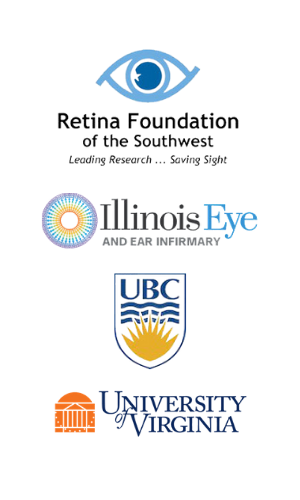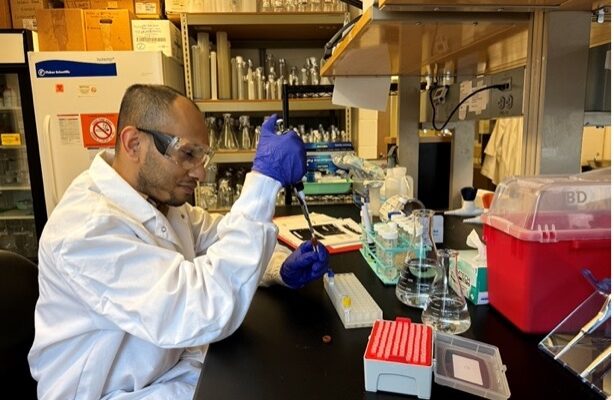

A Focus on Research
Funding research is at the heart of the Vision for Tomorrow Foundation.
Research makes it possible to better understand and more effectively treat the conditions that affect individuals with albinism or aniridia. Funding research allows us to envision a world where these conditions may be cured — or even prevented. We work closely with leading researchers in the field to identify treatments or preventions with the greatest impact on quality of life.
Vision for Tomorrow is the only Foundation in the United States funding oculocutaneous albinism (OCA) research and one of the few supporting aniridia specific research.
We are constantly working with scientists to better understand the ever-evolving discoveries in ophthalmology, genetics, biology and beyond to further advance work to better understand and improve challenges for those with low vision.
Research can be timely and costly so we are constantly working to raise funds to help drive new research. Please read more about our work and please consider a donation to help us further along our findings.
Our Research
Gene dosage manipulation alleviates manifestations of hereditary PAX6 haploinsufficiency in miceThe Vision for Tomorrow Foundation continues to partner with Ali Djalilian, MD, Professor of Ophthalmology on his ongoing investigations to improve cornea health for those with aniridia and other cornea trauma. Dr. Djalilian is the Director, Stem Cell Therapy and Corneal Tissue Engineering Laboratory at the University of Illinois Eye and Ear Infirmary at the University of Illinois at Chicago. Most recently he looked at the possibility of a normal copy of a paired gene being enhanced to make up for the non-functional copy. His groundbreaking work was published in the medical journal “Science Translational Medicine”, entitled “Gene dosage manipulation alleviates manifestations of hereditary PAX6 haploinsufficiency in mice”. VFT helped to make this work possible with a financial grant. Please consider a donation to VFT to fuel more important scientific findings that can help to better understand and more effectively treat ocular complications related to aniridia and albinism.
Defining Structure Function Relationships in Albinism
In a special collaboration, the Vision for Tomorrow Foundation is funding a joint project between Joseph Carroll, PhD, Professor at the Medical College of Wisconsin. The team will work to establish a more comprehensive, quantitative neurophysiological explanation of visual deficits in albinism and provide a framework for understanding the potential of emerging therapies. This will provide a basis for understanding the etiology of albinism and will assist in developing selection criteria to match patients with the most effective therapies tailored to their individual anatomic characteristics.


Past Research
Novel Topical Treatments in Pax6 Mutant Mice and Mice with Albinism
Principal Investigator: Arlene Drack, MD, Associate Professor in Pediatric Ophthalmic Genetics at the University of Iowa Department of Ophthalmology and Visual Sciences
Using ERG as an endpoint for drug efficacy in partners with aniridia and albinism
Principal Investigator: Arlene Drack, MD, Associate Professor in Pediatric Ophthalmic Genetics at the University of Iowa Department of Ophthalmology and Visual Sciences
Use of Providone-Iodine in treatment of Trachoma, a Leading Cause of Infectious Blindness
Principal Investigator: Sherwin Isenberg, M.D., Jules Stein Eye Institute at UCLA
Clinical Trial to Evaluate Levodopa as Treatment to Improve Vision in Individuals with Albinism
Principal Investigators: Carol G. Summers, M.D., University of Minnesota and Murray Brilliant, PhD, Director of Human Genetics, Marshfield Clinic, Wisconsin
Correction of Albinism Mutations by Targeted Genomic Rearrangement
Principal Investigator: Murray Brilliant, PhD, Professor in Genetics, University of Arizona
Search for new Genes Causing Albinism in Israeli Populations
Principal Investigator: Irene Anteby, M.D., Director, Center for Pediatric Ophthalmology, Hadassah Medical Center, Jerusalem
Assessing the Role of the PAX6 Gene in Aniridia
Principal Investigator: James D. Lauderdale, Ph.D., Assistant Professor, Department of Cellular Biology, College of Arts and Sciences, University of Georgia
Assessing Foveal Anatomy in Albinism and Aniridia Using High Resolution Retinal Imaging
Principal Investigator: Joseph Carroll, PhD, The Medical College of Wisconsin
Assessment of a Novel Treatment for Albinism
Principal Investigator: Brian S. McKay, PhD, Assistant Professor, University of Arizona
Correction of Albinism Mutations by Targeted Genomic Rearrangement: Phase II
Principal Investigator: Murray Brilliant, PhD, Professor in Genetics, University of Arizona
Assessment of a Novel Treatment for Albinism: Phase II
Principal Investigator: Brian S. McKay, PhD, Assistant Professor, University of Arizona
Support of Optic Program at Cincinnati Eye Institute
Principal Investigator: Edward Holland, M.D
Genes Controlling the Uncrossed Projection of Retinal Ganglion Cells in Pigmented and Albino Mice
Principal Investigator: Carol Mason, PhD, Professor Department of Pathology and Cellular Biology, Columbia University
Design and Fabrication of a Wide Angle 3x Array Telescope
Principal Investigator: Milton Katz, OD, Professor, State University of New York
Apply for a Grant
The Vision for Tomorrow Foundation is pleased to provide funding to qualified researchers whose research matches our needs.
- Be a clinical researcher, medical doctor, scientist, or clinically-trained professional
- Hold a relevant advanced degree (M.D., O.D. and/or Ph.D.) and have completed all research training
- Have an affiliation with a recognized hospital, university, clinic or laboratoryIf you are a qualified researcher in need of funding, please apply.
Letters of Intent are welcome at any time and will be reviewed when received.
Additional Resources
Retina Foundation of the Southwest
Illinois Eye and Ear Infirmary
University of Virginia


